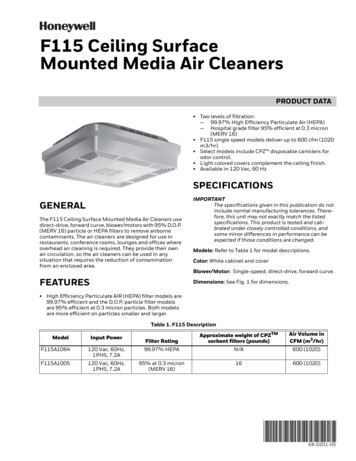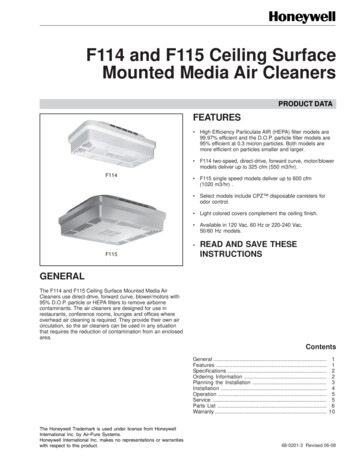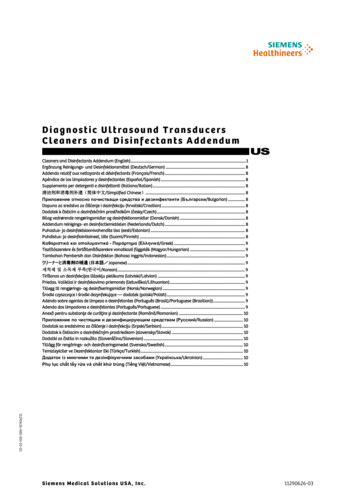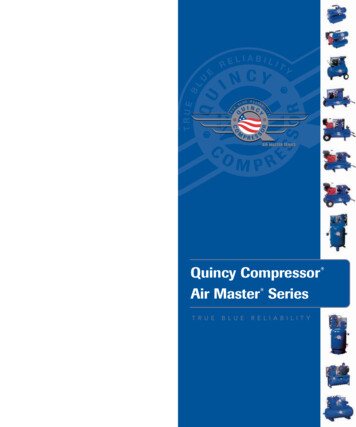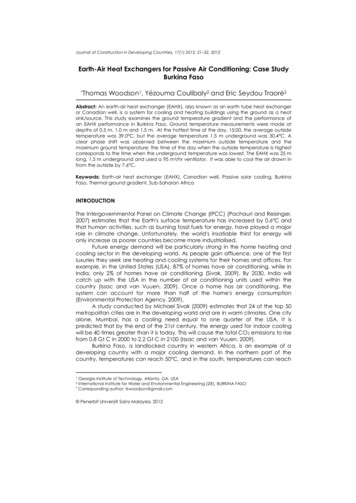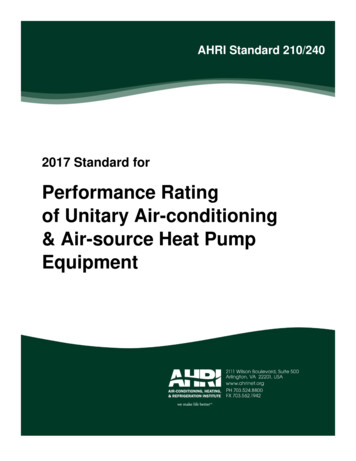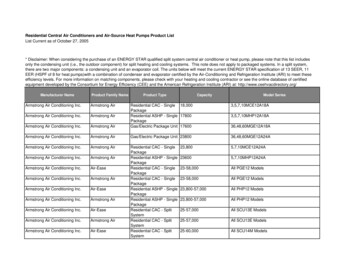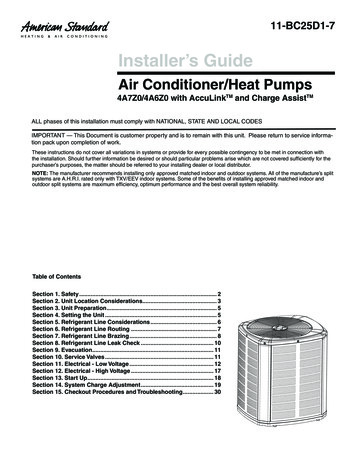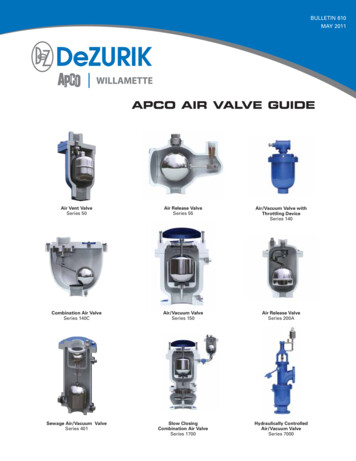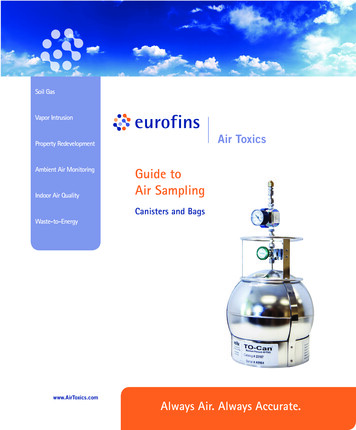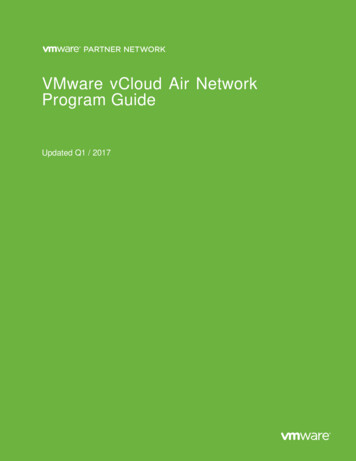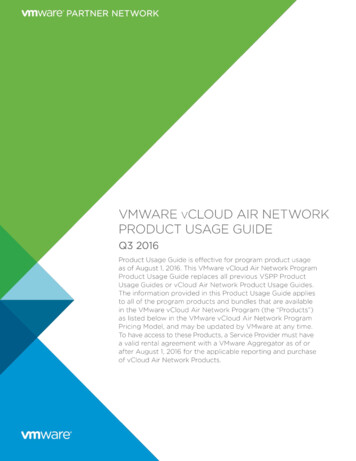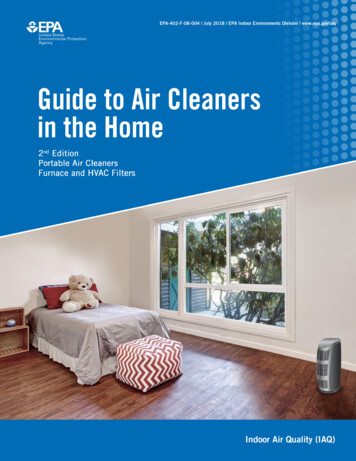
Transcription
Guide to Air Cleaners in the HomePortable Air Cleaners and Furnace or HVAC Filters in the HomeIndoor air contains pollutants that can affect human health. Some of these pollutants come from outdoors,and others come from indoor sources and activities, such as cooking, cleaning, secondhand smoke, buildingmaterials, consumer products, and home furnishings. These indoor air pollutants can be particles or gases,including volatile organic compounds (VOCs). Common contaminants that can be found indoors includeparticulate matter (including PM2.5 [fine] and PM10 [coarse]), formaldehyde, mold, and pollen. Indoor air qualitywill vary from home to home and over the course of a day within a home. Since most people spend about 90% oftheir time indoors, mostly in their homes, much of their exposures to airborne pollutants will happen in the home.The most effective ways to improve your indoor air are to reduce or remove the sources of pollutants and to ventilatewith clean outdoor air. In addition, research shows that filtration can be an effective supplement to source controland ventilation. Using a portable air cleaner and/or upgrading the air filter in your furnace or central heating,ventilation, and air-conditioning (HVAC) system can help to improve indoor air quality. Portable air cleaners, alsoknown as air purifiers or air sanitizers, are designed to filter the air in a single room or area. Central furnace or HVACfilters are designed to filter air throughout a home. Portable air cleaners and HVAC filters can reduce indoor airpollution; however, they cannot remove all pollutants from the air.2
Guide to Air Cleaners in the HomeTips For Selecting a Portable Air Cleaner, Furnace Filter, or HVAC FilterWhen selecting a portable air cleaner, furnace filter, or HVAC filter, keep in mind:No air cleaner or filter will eliminate all of the air pollutants in your home. Note that most filters are designedto filter either particles or gases. So in order to filter both particles and gases, many air cleaners contain twofilters, one for particles and another for gases (in some cases including gases that have odors). Other air cleanersonly have one filter, usually for particles. In addition, some air cleaners or filters are targeted to specific types ofgases or VOCs. Consult the specific product packaging or labeling for more information.All filters need regular replacement. If a filter is dirty and overloaded, it won’t work well.PORTABLE AIR CLEANERSTo filter particles, choose a portable air cleaner that has a clean air delivery rate (CADR) that is largeenough for the size of the room or area in which you will use it. The higher the CADR, the more particlesthe air cleaner can filter and the larger the area it can serve. Most air cleaner packaging will tell you thelargest size area or room it should be used in. Portable air cleaners often achieve a high CADR by using ahigh-efficiency particulate air (HEPA) filter.To filter gases, choose a portable air cleaner with an activated carbon filter or otherfilter designed to remove gases. Note that there are no widely used performance rating systems forportable air cleaners or filters designed to removegases. The CADR rating system is for particles only.Activated carbon filters can be effective, providedthat there is a large amount of material used in thefilter.A portable air cleaner with a high CADR and anactivated carbon filter can filter both particlesand gases.Generally speaking, higher fan speeds and longerrun times will increase the amount of air filtered.An air cleaner will filter less air if it is set at a lowerspeed. More air will pass through the filter at higherfan speeds, so typically filtration will be greater athigher fan speeds. Increasing the amount of time anair cleaner runs will also increase air filtration.Portable Air CleanerPortable Air Cleaner Sizing for Particle RemovalRoom area (square feet)100200300400500600Minimum CADR (cfm)65130195260325390Note this chart is for estimation purposes. The CADRs are calculated based on an 8-foot ceiling. Ifyou have higher ceilings, you may want to select a portable air cleaner with a higher CADR.3
Guide to Air Cleaners in the HomeFURNACE AND HVAC SYSTEM FILTERSFurnace and HVAC filters work to filter the air only when the system is operating. In most cases, HVAC systemsrun only when heating or cooling is needed (usually less than 25% of the time during heating and cooling seasons).In order to get more filtration, the system would have to run for longer periods. This may not be desirable orpractical in many cases since longer run times increase electricity costs and may also result in less reliable humiditycontrol during the cooling season.Furnace and HVAC filters for homes are usuallydesigned to filter particles. If you decide to upgrade oruse a higher efficiency filter, choose a filter with at leasta Minimum Efficiency Reporting Value (MERV) 13rating, or as high a rating as your system fan and filterslot can accommodate. You may need to consult aprofessional HVAC technician to determine the highestefficiency filter that will work best for your system.Furnace FilterFurnace or HVAC filter—Select a filter rated at least MERV 13 or as highas your system will accommodate.Other devices that do not have filters may alsoremove particles and gases. They usually fit insidethe HVAC ductwork and are more common in largeand commercial buildings. See the EPA technicaldocument, Residential Air Cleaners, 3rd edition, formore information: ion.EPA does not certify or recommend specific brands or models ofair filters or portable air cleaners.Q&A: Air Cleaning and FiltrationDo portable air cleaners and furnace/HVAC filters used in homes have the potential to improve my indoorair quality?Yes. Most portable air cleaners and furnace/HVAC filters can filter particles from the air. Some can filter the smallparticles of greatest health concern (PM2.5). There are also air cleaners and filters that can filter both particlesand gases. The longer the air cleaner runs, the more air it filters. Note that it is always important to reduce orremove the sources of indoor air pollutants and to ventilate with clean outdoor air. Filtration does not replace theneed to control pollutants and ventilate.Can portable air cleaners and furnace/HVAC filters potentially have a positive impact on health?Possibly. Several studies using portable HEPA air cleaners have demonstrated small improvements incardiovascular and respiratory health. The improvements are typically small and not always noticeable to theindividual, although they may be measureable by health professionals.For more information on particles and health, see: EPA Indoor Particulate Matter: ate-matter EPA Particle Pollution and Your Health: www3.epa.gov/airnow/particle/pm-color.pdf4
Guide to Air Cleaners in the HomeCan portable air cleaners and furnace/HVAC filters reduce allergy or asthma symptoms?Possibly. Multiple studies with portable HEPA air cleaners have found improvements in one or more allergyand/or asthma symptom(s). The studies do not always show major improvements, and they do not showimprovements in all symptoms.Can portable air cleaners and furnace/HVAC filters solve mold problems?No. Portable air cleaners and furnace/HVAC filters do not address the cause of mold and musty odors. Mold iscaused by a water or moisture problem in the building that allows the mold to grow. To solve a mold problem,get rid of the source of the moisture and clean up the mold. Portable air cleaners and furnace/HVAC filters mayremove some of the particles generated by mold. In some cases, they may also help reduce odors, but they willnot resolve a mold and moisture problem.Note: Avoid portable air cleaners and furnace/HVAC filters that intentionally produce ozone. Ozone is a lungirritant. Note that in some cases, air cleaners that contain electrostatic precipitators, ionizers, UV lights withoutadequate lamp coatings, and plasma air cleaners may have the potential to emit ozone. Both the California AirResources Board and the Association of Home Appliance Manufacturers maintain lists of air cleaners that havebeen tested and shown to emit little or no ozone.Q&A: Portable Air CleanersMost portable air cleaners have a CADR rating. What does that mean?Most portable air cleaners are rated according to their clean air delivery rate (CADR). This number is intended tohelp consumers select an air cleaner based on the size of the area it will be placed in. The higher the CADR, themore particles the air cleaner will remove and the larger the area it can serve. The rating is typically measured atthe air cleaner’s highest speed.How do I choose a portable air cleaner that will remove the small particles of greatest health concern (PM2.5)effectively?Some air cleaner packaging will indicate CADRs for removing three specific types of pollutants: tobaccosmoke, dust, and pollen. These pollutants are used as examples to represent small-, medium-, and largesized particles, respectively. To remove small particles, choose a portable air cleaner that has a high CADR fortobacco smoke, which represents the smallest particles. The CADR should be large enough for the size of theroom or area you will use it in.How do I calculate the size of the room or area in order to pick the right air cleaner?Multiply the length and width of the area in which you intend to operate the air cleaner. The result will provideyou with the size of the room or area in square feet. Compare this to the maximum recommended room sizeon the product packaging. If you have an open floor plan, you should consider the entire space that the aircleaner would serve. If you have high ceilings (above 8 feet), you should consider using an air cleaner thatis sized for a larger area. If you have an area that is larger than any available product will serve, you couldconsider using multiple air cleaners.5
Guide to Air Cleaners in the HomeHow do I choose a portable air cleaner that can remove volatile organic compounds (VOCs)?Choose a portable air cleaner with an activated carbon filter or other absorbent filter designed to removegases. They can be effective when there is a large amount of material used in the filter (the thicker the better).Research has not yet shown that other technologies such as plasma, photocatalytic oxidation, or ultraviolet(UV) light can remove gases effectively in portable residential air cleaners.Do portable air cleaners have noise ratings?Noise ratings are reported for some portable air cleaners. The ratingmay be shown on the product packaging. Noise levels depend in parton the fan speed setting. If noise might prevent you from running theunit, you might consider an air cleaner that has a low published noiserating. For reference, a noise rating around 50 decibels (dB) is roughlythe operating noise of a modern refrigerator.Where should I put a portable air cleaner?Consider placing the unit in the room(s) you spend the most time in.Many units are designed to be placed on the floor, although someare designed for tabletops. Either way, make sure the airflow is notobstructed. Keep air cleaners away from curtains and anything thatmight block airflow. If the air cleaner causes an uncomfortable draft,then redirect the airflow away from you.This is an example of a label from a portable aircleaner. Used with permission from the Association of Homes Appliance Manufacturers (AHAM).What does it mean if a portable air cleaner has the EPA’s ENERGY STAR label?Some portable air cleaners sold in the consumer market are ENERGY STAR qualified. The ENERGY STAR labelmeans that it meets strict energy efficiency guidelines set by EPA. The label does not refer to its air-cleaningeffectiveness in any way.Q&A: Heating, Ventilation, and Air-Conditioning (HVAC) System Filtersand Furnace FiltersHow are HVAC/furnace filters rated?There are several commonly used filter rating methods. These include the Minimum Efficiency Reporting Value(MERV), Filter Performance Rating (FPR), Microparticle Performance Rating (MPR), and others. MERV is basedon a national consensus standard. The FPR and MPR rating methods are proprietary. For all rating methods, thehigher the filter rating, the higher the removal efficiency for most particle sizes.How do I choose an HVAC/furnace filter that will be most effective at removing small particles of greatesthealth concern (PM2.5)?Use the highest-rated filter that your system fan and filter slot can accommodate. Filters with a MERV of 13 andabove are required to demonstrate at least 50% removal efficiency for the smallest particles tested.6
Guide to Air Cleaners in the HomeHow do I know if my system can accommodate a MERV 13 filter or higher?Most furnaces and HVAC systems can accommodate a MERV 13 filter without creating equipment problems,provided that the filter is replaced frequently. Sometimes it can be difficult to tell whether a system can use a higherefficiency filter since HVAC systems are not commonly labeled with any filter recommendations. To be certain a filterwill work with your system, consult a professional HVAC technician. The technician can determine the most efficientfilter that your system can use. An HVAC technician can also modify the system to use a higher efficiency filter.How can I tell if the filter is the right size for my furnace/HVAC system?Filters commonly come in thicknesses of 1 to 5 inches, with a variety of lengths and widths to match common sizesof filter frames in furnaces and HVAC systems. Make sure the filter fits snugly so air does not leak around the filterand you do not have to bend or crush the filter to make it fit.How often do I need to change my filter?Replace filters according to manufacturer’s recommendations. Many factors can affect how quickly filters get dirty.Manufacturers typica
Portable Air Cleaners and Furnace or HVAC Filters in the Home Indoor air contains pollutants that can affect human health. Some of these pollutants come from
